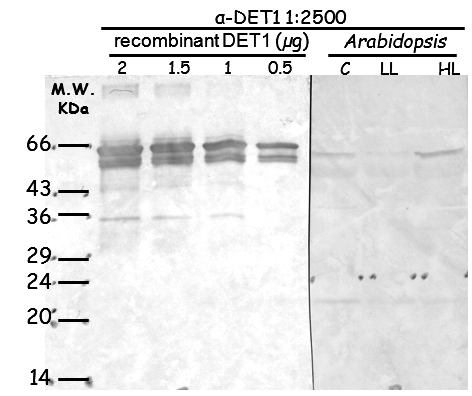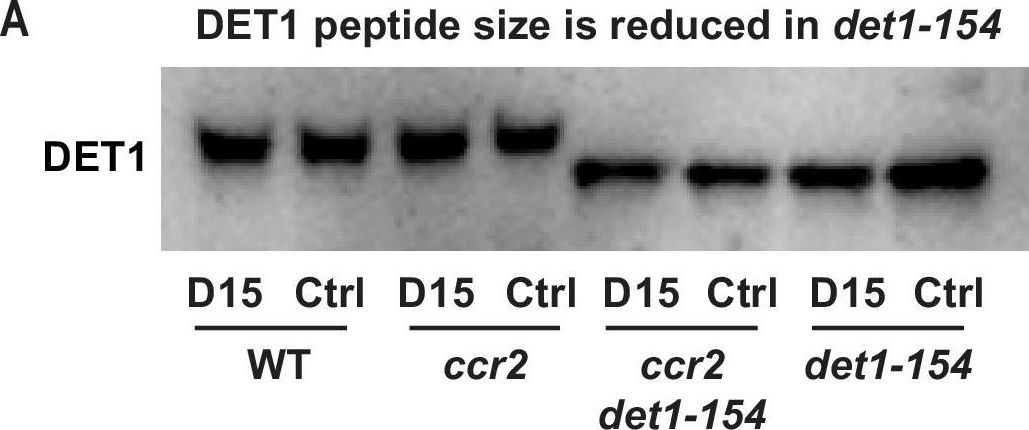1

Anti-DET1 | Regulator of the proteasomal degradation of LHY
AS15 3082 | Clonality: Polyclonal | Host: Rabbit | Reactivity: Arabidopsis thaliana
- Product Info
-
Immunogen: Recombinant, full length DET1 of Arabidopsis thaliana, overexpressed in E.coli, UniProt: P48732, TAIR: AT4G10180
Host: Rabbit Clonality: Polyclonal Purity: Serum Format: Lyophilized Quantity: 50 �l Reconstitution: For reconstitution add 50 �l of sterile water Storage: Store lyophilized/reconstituted at -20�C; once reconstituted make aliquots to avoid repeated freeze-thaw cycles. Please remember to spin the tubes briefly prior to opening them to avoid any losses that might occur from material adhering to the cap or sides of the tube. Tested applications: Western blot (WB) Recommended dilution: 1 : 2500 (WB) Expected | apparent MW: 62 | 62 kDa
- Reactivity
-
Confirmed reactivity: Arabidopsis thaliana Predicted reactivity: Capsicum annuum, Glycine max, Medicago truncatula, Oryza sativa, Populus trichocarpa, Ricinus communis, Solanum lycopersicum, Solanum tuberosum, Theobroma cacao, Zea mays, Zostera marina
Species of your interest not listed? Contact usNot reactive in: No confirmed exceptions from predicted reactivity are currently known - Application Examples
-
application example 
Recombinant protein (0.5-1-1.5-2 µg of protein) and total proteins from Arabidopsis thaliana whole leaves from plants grown in control light (C), low light (LL) and high light (HL), corresponding to 1 µg of chlorophylls, were extracted with loading buffer (10% glycerol, 62.5 mM Tris pH 6.8, 2% SDS, 5% β-mercaptoethanol) and denatured at 100°C (boiling water) for 1 min. Proteins were separated on 12% SDS-PAGE (Laemly) and blotted 1h to PVDF using tank transfer. Blots were blocked with blocking solution (PBS 1X, 0.2% w/v Tween, 5% powder milk) for 1h at room temperature (RT) with agitation. Blot was incubated in the primary antibody diluted in blocking solution, at a dilution of 1: 25,000 for 1h at RT with agitation. The antibody solution was decanted and the blot was rinsed briefly twice, then washed 3 times for 10 min in blocking solution at RT with agitation. Blot was incubated in secondary antibody (anti-rabbit IgG alkaline phosphatase conjugated) diluted to 1:30 000 in blocking buffer for 1h at RT with agitation. The blot was washed 2 times for 10 min in blocking solution and once with PBS 1X solution for 10 min, then developed in developing buffer developing buffer NBT/BCIP by manual agitation.
Courtesy of Stefano Cazzaniga, University of Verona, ItalyApplication examples: 
Reactant: Arabidopsis thaliana (Thale cress)
Application: Western Blotting
Pudmed ID: 32003746
Journal: Elife
Figure Number: 7A
Published Date: 2020-01-31
First Author: Cazzonelli, C. I., Hou, X., et al.
Impact Factor: 7.448
Open PublicationThe DET1-154 peptide is smaller in det1-154 mutant genotypes.(A) Representative western blot image showing the reduced DET1 peptide size in ccr2 det1-154 and det1-154 (59 kDa) compared to WT and ccr2 (62 kDa). Gel electrophoresis of the gel membrane from Figure 7C (electrophoresis for 38 min at 165 volt) was extended for 120 min at 100 volts to resolve the 3 kDa difference in DET1-154 protein size. Under these conditions, the 37 kDa ACTIN peptide and pre-stained ladder were not detected on the membrane. Proteins were extracted from WT, ccr2 and ccr2 det1-154 etiolated seedlings grown on MS media without (control; Ctrl) or with the chemical inhibitor of CCD activity (D15).

Reactant: Arabidopsis thaliana (Thale cress)
Application: Western Blotting
Pudmed ID: 32003746
Journal: Elife
Figure Number: 7C
Published Date: 2020-01-31
First Author: Cazzonelli, C. I., Hou, X., et al.
Impact Factor: 7.448
Open PublicationChemical inhibition of CCD activity revealed how a ccr2 generated apocarotenoid signal transcriptionally up-regulates POR and PIF3 in parallel to det1-154 during skotomorphogenesis.(A) Transcript levels of PORA, PIF3 and HY5 in WT, ccr2, ccr2 det1-154 and det1-154 etiolated seedlings growing on MS media (+ /- D15). Statistical analysis denoted as a star was performed by a pair-wise t-test (p<0.05). Error bars represent standard error of means. (B), (C) and (D) Representative western blot images showing POR, DET1, PIF3 and HY5 protein levels, respectively. Proteins were extracted from WT, ccr2 and ccr2 det1-154 etiolated seedlings grown on MS media without (control; Ctrl) or with the chemical inhibitor of CCD activity (D15). The membrane was re-probed using anti-Actin antibody as an internal loading control. Lattice-like symbol below POR western (B), represents formation of a PLB in etiolated cotyledons from that genotype and treatment. (E) Model describing how a cis-carotene derived cleavage product, ACS, regulates POR, HY5, PIF3 and PLB formation during skotomorphogenesis. DET1 maintains skotomorphogenesis by post-transcriptionally maintaining a higher and lower PIF3 and HY5 protein levels, respectively. HY5 promotes and PIF3 represses PhANG expression. det1 mutants trigger photomorphogenesis in that they lack POR mRNA transcripts, protein and a PLB. ccr2 generates ACS that enhances POR mRNA transcript and protein levels that enable PLB formation in det1-154. det1-154 restores PLB formation in ccr2 by blocking a signalling pathway acting independent of POR.The DET1-154 peptide is smaller in det1-154 mutant genotypes.(A) Representative western blot image showing the reduced DET1 peptide size in ccr2 det1-154 and det1-154 (59 kDa) compared to WT and ccr2 (62 kDa). Gel electrophoresis of the gel membrane from Figure 7C (electrophoresis for 38 min at 165 volt) was extended for 120 min at 100 volts to resolve the 3 kDa difference in DET1-154 protein size. Under these conditions, the 37 kDa ACTIN peptide and pre-stained ladder were not detected on the membrane. Proteins were extracted from WT, ccr2 and ccr2 det1-154 etiolated seedlings grown on MS media without (control; Ctrl) or with the chemical inhibitor of CCD activity (D15).
- Additional Information
-
Additional information: This product can be sold containing ProClin if requested - Background
-
Background: DET1 (regulator of the proteasomal degradation of LHY) is a component of light signal transduction (repression of photomorphogenesis in darkness) machinery, localized in nuclei.
Alternative name: Protein DEETIOLATED 1. - Product Citations
-
Selected references: Castells et al (2011). The conserved factor DE-ETIOLATED 1 cooperates with CUL4-DDB1DDB2 to maintain genome integrity upon UV stress. EMBO J. 2011 Mar 16;30(6):1162-72. doi: 10.1038/emboj.2011.20. Epub 2011 Feb 8. - Protocols
-
- Reviews:
-
This product doesn't have any reviews.



